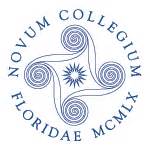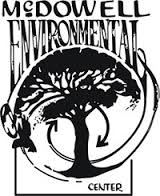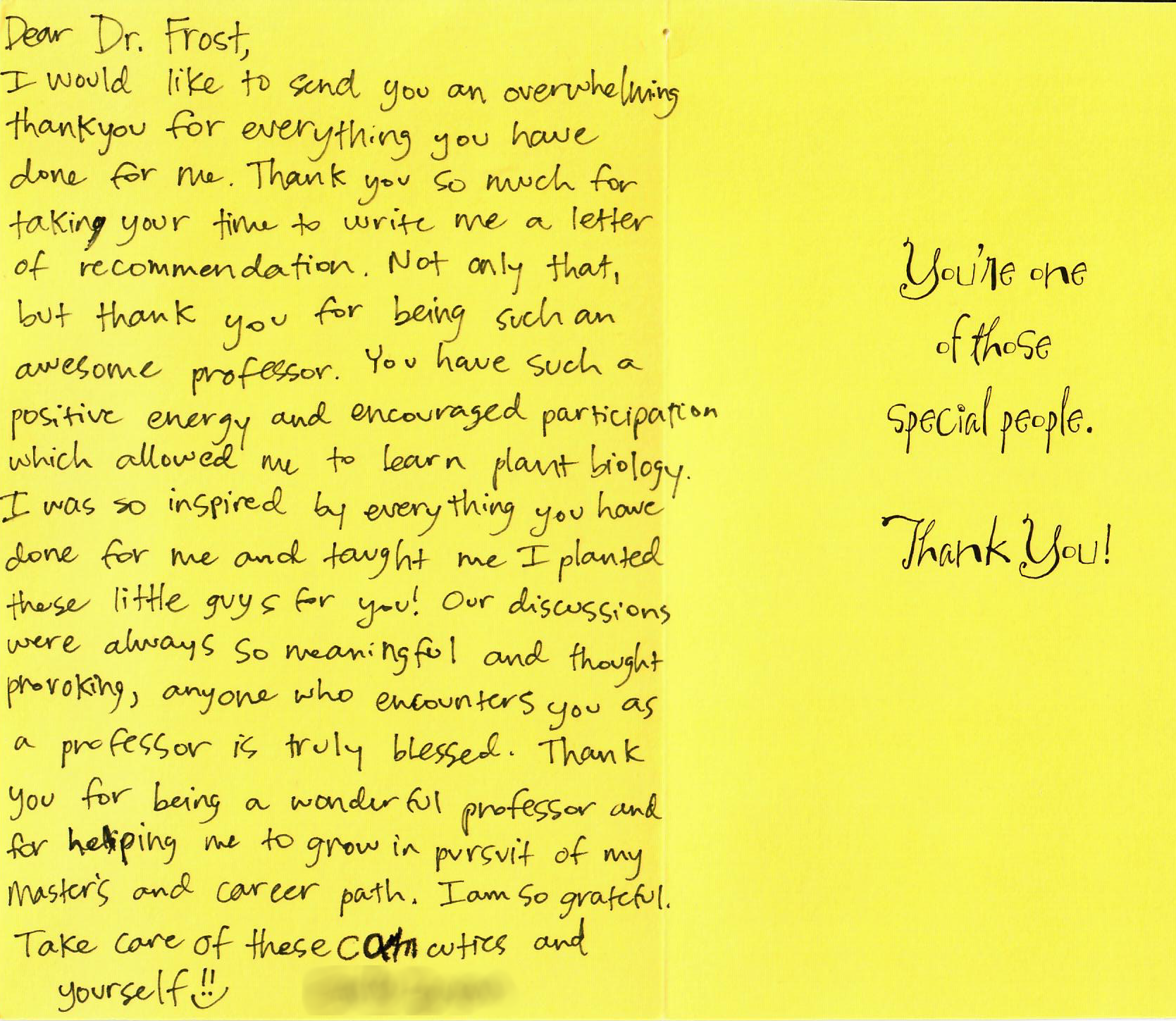The Frost Laboratory: Integrative and Applied Chemical Ecology
Christopher J. Frost
A Narrative CV
 My path has been anything but linear, and there have been a few career changes along the way. This narrative version of a Curriculum Vitae is meant to tell a small bit of that story, and describe the foundational aspects of my academic development is a way seldom captured by a typical CV's lists of accomplishments.
My path has been anything but linear, and there have been a few career changes along the way. This narrative version of a Curriculum Vitae is meant to tell a small bit of that story, and describe the foundational aspects of my academic development is a way seldom captured by a typical CV's lists of accomplishments.
I was born in Tucson, Arizona and lived there for seven years. During these early formative years, my parents introduced me to the diverse natural habitats of Arizona. My earliest memories include hikes in the Rincon Mountains and Sabino Canyon. By the time I was six, I had hiked and camped in habitats from the snow-capped Catalina Mountains to the desert of the Saguaro National Monument. This early appreciation for nature would later become the foundation for my life goals.
 At Huntingdon College, I poured my effort into the pursuits of scientific academia simultaneously studying Biology and Chemistry. I was also fortunate to travel to Costa Rica, Belize, and Guatemala, experiencing different cultures and to be exposed to the beauty of tropical habitats and medicinal plants of these areas. After two years, I transferred to New College of Florida but, before matriculating, I had the opportunity to live in the Amazon Basin of Peru as an environmental educator/naturalist. This exposure to the Amazon was a powerful influence on my life as I interacted with and befriended an indigenous group named the Bora, who taught me about the medicinal plants of the area. This was one of my early exposures to plant chemical ecology, and has helped shape my thought processes related to the evolutionary history of defense chemistry. The welcoming people and awe-inspiring natural areas of the Peruvian Amazon would weave their way into my soul.
At Huntingdon College, I poured my effort into the pursuits of scientific academia simultaneously studying Biology and Chemistry. I was also fortunate to travel to Costa Rica, Belize, and Guatemala, experiencing different cultures and to be exposed to the beauty of tropical habitats and medicinal plants of these areas. After two years, I transferred to New College of Florida but, before matriculating, I had the opportunity to live in the Amazon Basin of Peru as an environmental educator/naturalist. This exposure to the Amazon was a powerful influence on my life as I interacted with and befriended an indigenous group named the Bora, who taught me about the medicinal plants of the area. This was one of my early exposures to plant chemical ecology, and has helped shape my thought processes related to the evolutionary history of defense chemistry. The welcoming people and awe-inspiring natural areas of the Peruvian Amazon would weave their way into my soul.
 At New College, a course in Field Botany solidified my love of plants. During the academic year, I immersed myself in the diverse habitats of Florida, from pine flatwoods to coastal hammocks to the Everglades. During the summers, I returned to Peru to teach American children about the tropical rainforest and other cultures, developing and implementing curriculum with a biocultural emphasis. I graduated with a double concentration in Biology and Environmental Studies, successfully completing a thesis on the genus Capsicum: the chile peppers. This inspired a life-long love of all things spicy, and an ongoing search for the ideal mix of flavor and spice.
At New College, a course in Field Botany solidified my love of plants. During the academic year, I immersed myself in the diverse habitats of Florida, from pine flatwoods to coastal hammocks to the Everglades. During the summers, I returned to Peru to teach American children about the tropical rainforest and other cultures, developing and implementing curriculum with a biocultural emphasis. I graduated with a double concentration in Biology and Environmental Studies, successfully completing a thesis on the genus Capsicum: the chile peppers. This inspired a life-long love of all things spicy, and an ongoing search for the ideal mix of flavor and spice.
A formative experience during this time was an Outward Bound canoe trip in the Everglades (while I was a student at New College). Our group went a stretch of six days without touching solid ground. We paddled through bio-luminescent microorganisms that lit the night with an eerie green light with each paddle stroke. We spent nights on a raft of our collective canoes, and enjoyed solo sleeping on untouched beaches.
 After college, I worked as an Environmental Educator at the McDowell Environmental Center in Nauvoo, Alabama. At the center, I instructed students of diverse socioeconomic classes from grades 3 to 8 in various aspects of environmental science. Classes included study of pond, stream, and temperate forest habitats and the organisms that live within them, and group action initiatives where students were challenged to problem solve collectively and develop cooperation skills. Each class was coupled with exercises that demonstrated a particular process, from the water cycle to the movement of nutrients in a tree to the biological effects of pollution.
After college, I worked as an Environmental Educator at the McDowell Environmental Center in Nauvoo, Alabama. At the center, I instructed students of diverse socioeconomic classes from grades 3 to 8 in various aspects of environmental science. Classes included study of pond, stream, and temperate forest habitats and the organisms that live within them, and group action initiatives where students were challenged to problem solve collectively and develop cooperation skills. Each class was coupled with exercises that demonstrated a particular process, from the water cycle to the movement of nutrients in a tree to the biological effects of pollution.
As a graduate student in the School of Forest Resources and Conservation at the University of Florida, I designed my research involved cultural influences on attitudes, perceptions, and knowledge of forests and forest ecosystems. The two general cultural paradigms are the Florida public and the inhabitants of the Peruvian Amazon in and surrounding Iquitos, Peru. I was honored to be mentored by Martha Monroe, and TA the Tree Biology course with John Davis. I completed the Master of Science in August 2000.
Putting plant chemical ecology into the context of trait-mediated ecological interactions took shape with my doctoral research, and I was spoiled to have Mark Hunter as a friend and mentor. Herbivores can influence terrestrial ecosystem functioning through a number of mechanisms. Deposition of waste produces (frass) introduces labile nitrogen (N) and other nutrients directly to the soil, potentially altering soil N availability. Herbivores stimulate changes in the chemistry and nutrient allocation patterns of plant tissues, which may indirectly affect N uptake dynamics and ecosystem N cycling. These processes occur rapidly and are "fast" cycle components of the terrestrial N cycle. Herbivore-mediated changes to the chemistry of foliage may alter rates of leaf litter decomposition, which is a "slow" cycle component of the terrestrial N cycle. My dissertation investiated the direct and indirect effects of insect herbivores on "fast" and "slow" cycle N dynamics in forest ecosystems.
For my dissertation, I directed the first study to provide mechanistic evidence that aqueous N export from terrestrial systems can result from frass deposition, directly linking terrestrial and aquatic ecosystems within a forested watershed. I then showed that herbivore-mediated changes to leaf chemistry can influence leaf litter decomposition and nutrient release rates. Then, using stable isotopes, I show that the majority of N in frass was retained in the surface soil (likely bound into stable soil organic matter, indicating that surface soils are strong sinks for exogenous, labile N. And, I used a dual isotope labeling experiment to show that foliar herbivores induce changes in belowground carbon allocation (BCA) via root exudation, which affects rhizosphere microbial activity and was the first to show that BCA in oaks is altered by foliar herbivores and have implications for carbon cycling and sequestration in forest ecosystems.
My dissertation solidified my interest in plant defense ecology, and I realized that I needed to develop expertise in molecular ecology to accentuate mechanistic chemical ecology related to plant defense. Poplar emerged as an excellent system for this direction because the genome had recently been sequenced and the first gene annotation was available. My longstanding interest in induced defense and plasticity led me to wonder whether plants could sense changes in their environment related to their defense physiology, in much the same way as environmental stimuli such as light and temperature affect plant physiology. I was again fortunate to interact closely with Jack Schultz and Heidi Appel, whose creative approach to plant chemical ecology was both inspiring and like-minded. These interactions led to some really fun science down the fascinating road of what I have termed "preemptive environmental sensing." I have spent a number of years generating supporting evidence for the phenomenon and convincing myself of it's plausibility. But there is so much more to know. What conditions favor preemptive environmental sensing? What are the molecular mechanisms allowing for it?
While there is no doubt that my time as a postdoc was a highly productive and creative time for me, it was also a time of change. My first child was born in the Fall of 2008, and my life has never been the same. While I always considered myself a decent scientist, my role as a dad catapolted to the highest priority in my life. It still holds that place.
With my thoughts centered on plant environmental sensing, I also became increasingly interested in effects of global change on plant defense plasticity. There is a well-accumulated literature indicating the negative impact of abiotic stress on plant susceptibility to pests. I wondered whether this might be due in part to weakened ability of plants to engage induced defenses. This seems to be case, and the ecological potential of attenuated induced resistance in the face of environmental change has serious consequences for ecological interactions in the coming decades and is a topic for which I continue to invest considerable intellectual time.
Because I was not yet diverse enough, and because I have a real fondness for Athens, GA, I accepted a assistant research scientist position with CJ Tsai at the University of Georgia. I was part of a group that was studying the role of sucrose transporters (the SUT gene family) on the physiology and drought tolerance of the woody plant genus Populus (the aspens and cottonwoods). Most of the work from this time is now published, wherein we show a key role for a tonoplast (vacuole membrane) SUT on sucrose homeostasis and drought resilience. It was a great working environment that provided an unparalled opportunity to expand my understanding of plant molecular biology and metabolomics.
And now for something completely different. In 2012, I made a decision to shift focus away from academic research and redeploy my career to medical imaging informatics. It was one of the best decisions I have made in my life. I learned how my background in data analysis could be applied in real-world situations, and I learned coding skills that have made me a better scientist. I also had the opportunity to leverage my skills as part of a collaboration with radiologists to discover predictors of the clinical prevalence of a number of diseases. I was also involved in projects that honed the clinial capacity of fMRI as a diagnostic tool. This led to two publications that are both well-cited and, according to the radiologists, likely saving lives. This was my first published experience in conducting research with biomedical outcomes.
Two years into my career change, I had an unexpected opportunity to be hired as a Visiting Assistant Professor at my alma mater, New College of Florida. Back to the bay that held (and holds) so many memories. I was lucky to meet a number of students with whom I still interact, and whose ongoing career successes give me great joy. Two of these students are now NSF GRFs, and many have published peer-reviewed articles! While there, I also developed my first version of the Peru field course, and had some time to re-experience the wonder of NCF.
My experience at New College taught me that I was a decent educator, but I hadn't yet developed my own research lab and secured funding for that lab. In 2017, I did just that and was humbled and honored to be awarded my first NSF research grant as a faculty member in 2017. I was able to build a lab focused on discovering fundamental ecological and molecular aspects of plant defense and priming. Working with undergraduate students continued to be a central defining part of my efforts, and the lab produced three thesis students, numberous independent study students, and co-authors on peer-reviewed science! During that time, I also developed five classes, as well as continued the international field course to the Peruvian Amazon that I had developed at New College. A few of the papers from that time are published, but more stories are still in the works!
While focused on the effort to understand plant defense chemistry and sensory perception for both understanding of ecological process and applications to enhancing food security, I also sought opportunities to leverage my expertise in ways that could benefit human health. I teamed with a cancer biologist to discover that a common plant volatile terpene, β-Caryophyllene (BCP), affects the growth and development of aggressive triple negative breast cancer cells. We secure funds to conduct RNA-sequencing and biochemical assays showing that BCP stimulates a near complete upregulation of the cholesterol biosynthetic pathway, as well as stimulating cholesterol biosynthesis itself. We are now in the process of investigating the biology of this discovery, with the hopes that it may lead to novel treatments of this deadly disease.
In 2020, I returned to my birthplace, Tucson. The BIO5 Institute at the University of Arizona offered me a faculty position, and have been honored to be a part of a diverse and successful group of scientists! I am excited by the opportunities that exist for collaboration with my colleagues at UofA and our lab team as we continue to pursue the basic and applied science of plant chemical ecology!



